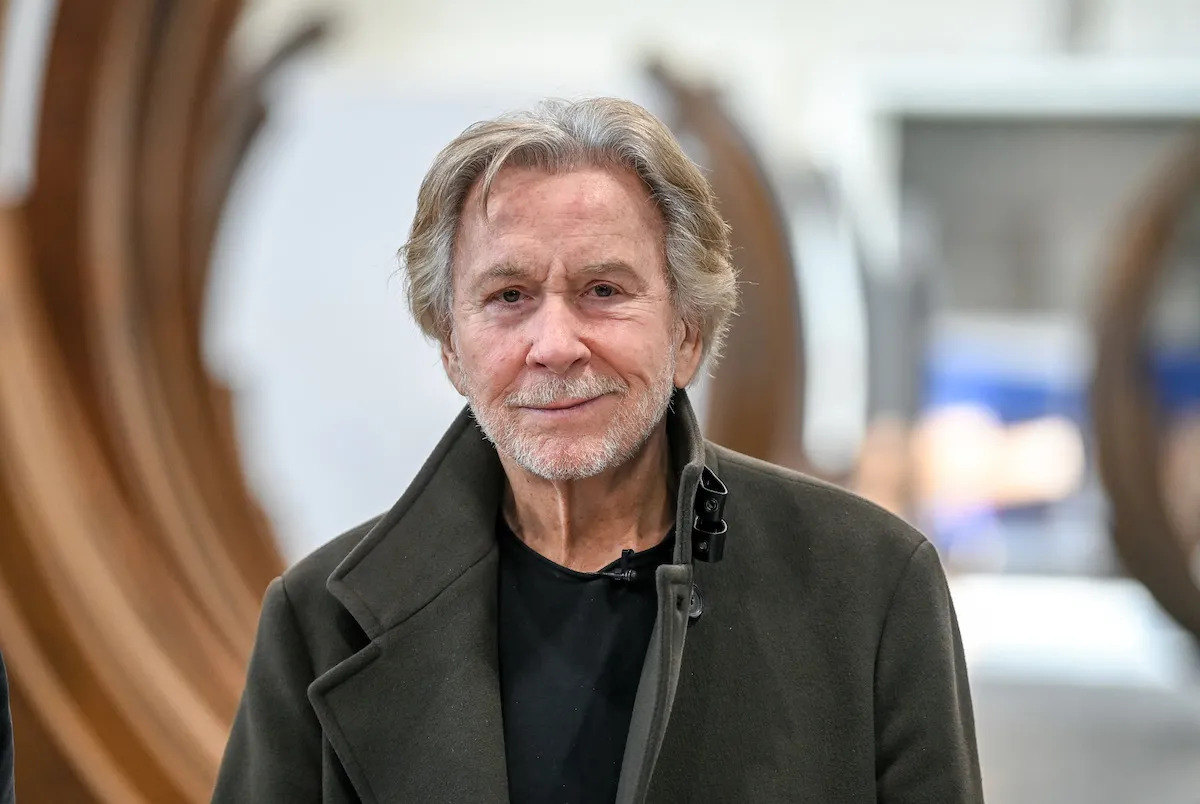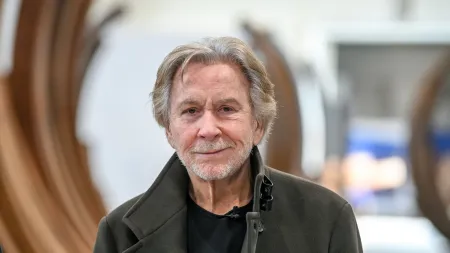
With no fewer than four solo exhibitions last summer in France, Bernar Venet was everywhere in home country, from Nice’s Le 109 arts space, which showed a large selection of works made in 1963, to Château de Montsoreau-Museum of Contemporary Art, which focused on his conceptual period. At Meisenthal’s Halle Verrière, there was a show about his “Effondrements” (Collapses) sculptures, a grouping of Cor-Ten steel arcs piled on top of one other, and at the Musée Fabre, there was a presentation about how his works in dialogue with Gustave Courbet’s Realism and Pierre Soulage’s all-black abstract paintings.
Across these presentations, it was evident that Venet is more than just the sculptor of the giant steel scultpures for which he is today best known. These sculptures have been shown in venues from Paris’s Centre Pompidou to Seoul’s Leeum Museum of Art, but despite his international prominence, full Venet retrospectives have been rare—especially in France, where he has yet to have a full-dress show on the scale that he has in other countries.
This week, in Venice, in a show held in to coincide with the opening of the Biennale, Venet will exhibit objects related to some of his earliest conceptual artworks, from the early 1960s, he recently inked a representation deal with the Bigaignon gallery, which will specifically show his photography, a lesser-seen part of his work. Meanwhile, the Paris 2024 committee, the group that facilitates art commissions tied to the Olympics, has commissioned Venet to create a work to make one of his steel arcs for a site in a park near the Stade de France and Saint Denis’s Olympic Aquatic Center, the only building that has been constructed specially for the games this summer.
As an artist who’s worked in many different mediums, Venet said in an interview that he defies labels. “My work is not about immediate seduction,” he explained. “It’s a language that needs to be learnt. One must understand the logic of an artwork in order to fully appreciate it. I am always looking for the right equation, solution, which convinces rather than persuades.
“Why limit oneself to one idea, when there is so much to be created?” the 82-year-old artist continued. “Sure, there is a constant in my exploring the line, but I try to take it to different places.”
Born in the south of France in 1941, Venet initially showed a taste for drawing and painting, not sculpture. At age 11, he chanced upon a book on Pierre-Auguste Renoir. As he was turning the pages, it hit him: art would be his reason to live.
He moved toward sculpture in 1961 while he was serving in the military. “In the 1960s, abstract art was over,” Venet recalled. “Pop art and New Realism and Narrative Figuration prevailed. No one wanted my tar paintings or my Pile of Coal,” a famed 1963 sculpture that is exactly what its title says.

That year was the one Venet began to forge an artistic connection that would help sustain his career. Through the artist Ben, Venet met the sculptor Arman in 1963. Venet sold a work that Arman the latter had gifted him, to pay for his first plane ticket to New York City, where he was introduced to Minimalist art. Arman continued to support him, giving him one dollar every day to buy some food and water, until he forgot all about Venet for an entire weekend. The artist remembers that weekend fondly.
It was around this time that Venet changed his first name from Bernard to Bernar. “It seems more ink has been spilled over the matter than over my art,” he said, laughing. “To be honest, I am not sure why I did it anymore. Bernard is hybrid. Bernar without the final letter sounded stronger, more impactful, somehow more ‘black.’… It is closer to my tar-coated pieces,” which were originally done on cardboard or paper.
In his 20s, Venet positioned himself against Abstract Expressionism and lyrical abstraction, which at the time were the most critically acclaimed—and the most financially viable—artistic tendencies. “The market did not care about me, which allowed me to go further and further in my investigations,” he said. To this day, he considers his most radical piece Représentation graphique de la fonction y=x²/4 (1966), This painting, which depicts an algebraic function, was acquired by the Centre Pompidou in 2006. “You can tell that the line will become the essential component of my work,” he said. “The equation paves the way for my mathematical paintings.”
Although much of Venet’s output since then has been sculpture, Venet said he had never abandoned painting: “I must insist on one thing: I am not a painter more than I am a sculptor, a performer more than I am a photographer. This is very important.” Instead, he simply considers himself an artist, relying upon whichever medium best suits his conceptual concerns.
“When I resumed to painting, in 1976, I opted for simple geometrical figures, leaving my canvases in the field of self-referentiality, of monosemy (as opposed to the concepts of pansemy and polysemy, respectively associated to his abstract and figurative creations). With those new canvases, I embraced aesthetic considerations that used to be excluded from my conceptual works. I then began to pay attention to the off-white quality of a background, to choose more carefully the greys I should use to paint this or that line.”

After some 50 years in the States, Venet returned to France. Eight years ago, he created the Venet Foundation, in Le Muy, next to Nice. He often describes it as a work of total art.
“I started with nothing,” he said. “I wanted to give back to society, to whom I owe everything I have possess. My children have perfectly understood, when explained it to them.”
This nearly 20-acre estate is home to about 100 works by people ranging from Fluxus artist Ben to the late sculptor Arman. Yet his holdings are not just limited to Frenchmen: he also owns art by American Minimalists like Donald Judd and Sol LeWitt, as well as British sculptures like Anish Kapoor and Anthony Caro. Those works are accessible to the public. Venet is also building a private collection that includes drawings by Matisse and Picasso.

The grand size of Venet’s foundation is in some ways mirrored by the scale of his sculptures. In 2019, he unveiled Arc Majeur, a 250-ton steel arc surrounding a Belgian highway that holds the record for the biggest artwork in Europe. He had the idea for it in 1985, and it took 30 years to make this project happen. Last summer, after joining Perrotin’s roster, he presented two giant stack of monumental arcs in the middle of Paris’s emblematic Place Vendôme. But he is not done yet.
He teased two projects. This summer, a 3D avatar of Venet will welcome the visitors to the artist’s foundation in Le Muy. He was interviewed last year covered with sensors meant to capture all his coming and goings, and any of his movements. “Not only will this avatar have my voice, but it will also borrow my attitude,” he said. “It has a pedagogical purpose.”
The second project Venet is very excited about is planned to mark the 200th anniversary of Nice’s 1860 annexation to France. It’s a mysterious work set to be produced and unveiled in 2058, long after Venet is dead—if it is ever realized at all. No one knows what it will look like. “It will be up to the municipality to fund its fabrication,” he said with a hint of mischief. “Or not. Who knows if I will be remembered by then.”
Indigenous Artists Take Venice Biennale’s Top Prizes as Mataaho Collective, Archie Moore Win Big
Stolen Salvator Rosa Painting Returned To Oxford University Gallery After Four Years

Inside the Hidden World of VIP Perks at America’s Marquee Sports Arenas

Emily Blunt Favors Florals in Embroidered Navy Jumpsuit at ‘The Fall Guy’ Premiere in Berlin with Ryan Gosling

Next year’s iPhone 16 rivals might feature huge batteries – here’s why that might be a problem

Sprinter Gabby Thomas Says Diamond League FloSports Deal Is a Drag


